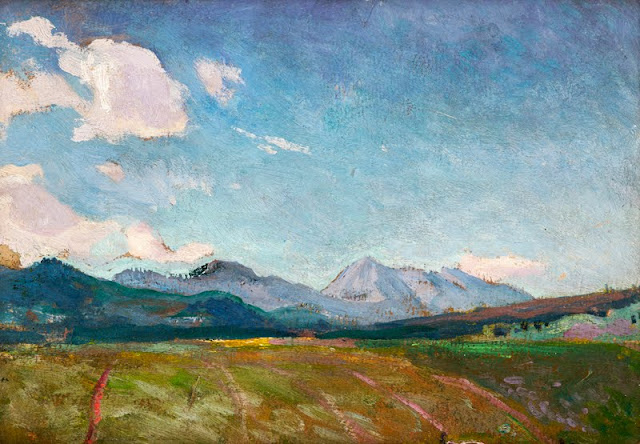JAN STANISLAWSKI (1860-1907)
Giewont (1,895 m- 6, 217 ft)
Poland
In Evening under Koziniec, oil on canvas, 1906
The mountains
Giewont is a mountain massif in the Tatra Mountains of Poland. It is 1,895 m - at its highest.
The massif has three peaks (all m/metres in AMSL):
- Great Giewont - Wielki Giewont (1,895 m- 6, 217 ft)
- Long Giewont - Długi Giewont (1,867 m- 6, 125 ft)
- Small Giewont - Polish Mały Giewont (1,728 m - 5,669 ft)
There is a mountain pass located between Great and Long Giewont, known as Szczerba (1,823 m- 5, 980 ft). Long Giewont and Great Giewont are situated at a higher altitude than the nearby town of Zakopane, making them clearly visible from that city.
On Great Giewont, there is a 15 m steel cross (erected in 1901) - the site of religious pilgrimages. The area is notorious for its hazardous nature during thunderstorms, so this should be taken into consideration when approaching the summit.
The first recorded ascent to Giewont's summit was undertaken in 1830 by Franciszek Herbich and Aleksander Zawadzki (a19th century explorer). The first winter ascent of Giewont occurred in 1904 by a group of five mountaineers led by Mariusz Zaruski. Nowadays the climbing on Giewont is strictly banned. On the other hand, hiking on the hiking trails is allowed and the access (except the winter) is not difficult hence Giewont is a very popular destination among amblers and Sunday tourists. In the summer up to few thousands tourists a day ascend the top.
Giewont lies in the area of the Polish Tatra National Park (Tatrzański Park Narodowy). In Polish folklore it is associated with a legend about oversleeping knights, who will awake when Poland is in danger.
The painter
Jan Stanisławski was a Polish modernist painter, art educator, founder and member of various innovative art groups and literary societies. He began to learn painting at the art studio in Warsaw which later gave rise to the School of Fine Arts, under Wojciech Gerson. In 1885, he continued his studies in Paris under Charles Emile Auguste Durand. While based in Paris, he travelled much, visiting Italy, Spain, Switzerland, Germany, Austria and eastern Galicia.His early works were exhibited at the inauguration of the Salon du Champ-de-Mars in Paris in 1890 and at the Kraków Society of Friends of Fine Arts in 1892. In the 1890s, he travelled extensively and his sketchbooks filled up with drawings from Berlin, Dresden, Prague, Kraków, and various places in Ukraine. In 1897, he initiated and helped organise the Separate Exhibition of Painting and Sculpture at Kraków’s Cloth Hall. That year, he became a teacher of landscape painting at the School of Fine Arts in Kraków, and in 1906 – after the school was upgraded to an academy in 1900 – was granted full professorship and also taught at Teodor Axentowicz’s Private School of Painting and Drawing for Women and at Teofila Certowicz’s Art School for Women in Kraków.
He co-founded the Society of Polish Artists "Sztuka" ("Art") in Kraków in 1897. In 1898, he became a member of the Viennese Secession, and his works were exhibited among theirs in 1901, 1902 and 1905. In 1901, he became a founding member of the Polish Applied Arts Society. He worked in the Wawel Castle Reconstruction Committee and was involved in the activities of the Green Balloon (Zielony Balonik) Cabaret. After his death, two exhibitions were opened at the Palace of Art by the Kraków Society of Friends of Fine Arts in November 1907, one to show 154 of his oil paintings, as well as drawings and watercolours, and the other to present the works of his numerous outstanding students.
_______________________________
2018 - Wandering Vertexes...
by Francis Rousseau









